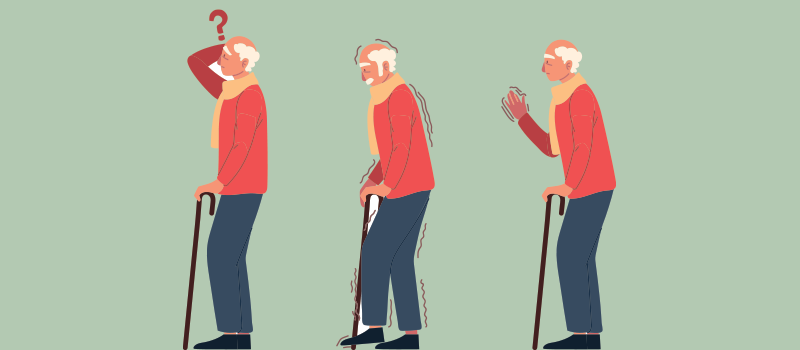What’s the Buzz
The Bee Healthy Blog
Using DBS (Deep Brain Stimulation) to Treat Parkinson’s

Deep brain stimulation (DBS) is one of the surgical treatments performed to treat Parkinson's disease. It involves the placement of a deep brain stimulator (metal wires in the brain connected to a pulse generator in the chest). Abnormal electrical signals in the brain cause the motor complications seen in Parkinson’s disease. Deep brain stimulation works by regulating electrical stimulation in certain parts of the brain.
DBS surgery can relieve many of the debilitating symptoms related to motor function in Parkinson’s patients. It can also decrease the need for Parkinson’s medications in some people. However, DBS is not for everyone. Please continue reading to learn more about the DBS device and procedure.
What is deep brain stimulation (DBS)? How does it work?
Deep brain stimulation (DBS) is a surgical procedure that involves the placement of electrodes in certain areas of the brain, such as the subthalamic nucleus or basal ganglia. The electrode placement is done by a surgeon. It helps to deliver electrical stimulation in the form of bilateral deep brain stimulation.
The amount of stimulation the DBS electrodes provide is controlled by a cardiac pacemaker-like device placed in the upper chest. The DBS system also includes an extension wire or wires connecting the implant device in the chest to the DBS lead or electrodes in the brain.
As mentioned above, abnormal electrical impulses from nerve cells cause severe motor fluctuations in Parkinson’s patients. DBS electrodes deliver continuous electrical pulses to regulate these abnormal electrical signals generated by the brain cells, thus providing relief from motor symptoms to Parkinson’s patients.
What conditions have deep brain stimulation DBS had success in treating?
In addition to Parkinson’s disease, DBS devices are also used to treat essential tremors, epilepsy, dystonia, psychiatric disorders like obsessive-compulsive disorder, Tourette’s syndrome (tics), chorea, Huntington’s disease, cluster headaches, and chronic pain.
Is DBS FDA-approved for Parkinson’s?
Deep brain stimulation was FDA approved to treat Parkinson’s in 2002 following clinical trials.
Who is the best candidate for DBS surgery?
The best candidate for DBS surgery is someone:
- Who has had a Parkinson's diagnosis for at least four years;
- Who benefits from Parkinson’s medication but has motor complications such as significant "off periods” when motor symptoms return because the medication is not effective;
- Who has motor fluctuations and/or dyskinesias (uncontrolled, involuntary movements) or refractory tremors that are not adequately controlled with PD medications;
- Who has minimal PD symptoms like instability, gait difficulties, and speech problems during the “on periods,” indicating an excellent response to levodopa;
- Who has normal or minimally affected cognitive, psychiatric, and behavioral functions;
- Who has no serious medical comorbidities.
It is worth noting that most patients who undergo DBS surgery have Parkinson's disease onset at a relatively young age and are less than 70 years of age at the time of the procedure. However, the ultimate decision about patient management is based on each individual’s medical history and disease progression.
The key to the success of deep brain stimulation (DBS) is the proper selection of ideal patients for this procedure. The selection of patients for deep brain stimulation is based on a detailed evaluation by a team of multidisciplinary experts in neurological disorders, including a movement disorders neurologist, neuropsychologist, psychiatrist, and neurosurgeon.
How effective is DBS for Parkinson's?
Deep brain stimulation surgery can lead to a significant improvement in motor symptoms such as slowness, stiffness, tremors, and dyskinesias. It can also result in lower medication doses in some patients. However, the DBS procedure does not work as well for symptoms such as freezing of gait, imbalance, and other non-motor symptoms. Deep brain stimulation can actually worsen thinking and memory problems in some patients. Therefore, DBS is usually not recommended for people with dementia symptoms.
Does DBS stop Parkinson's progression?
Deep brain stimulation (DBS) does not stop the progression of Parkinson’s disease. It is not a cure for Parkinson’s and does not stop the disease from getting worse. However, DBS surgery can help to lessen Parkinson's disease symptoms like tremors, dyskinesias, slowness, stiffness, and problems with walking. Deep brain stimulation can also help to lower the doses of PD medications. However, symptoms like speech impairments, poor posture, freezing, and balance problems may be persistent even after DBS surgery.
How long does DBS (deep brain stimulation) surgery last?
DBS brain surgery takes 4-6 hours to perform. It is an outpatient procedure that is performed in a medical center by a neurosurgeon using general anesthesia. The area of the brain where the DBS electrodes will be placed is determined using magnetic resonance imaging before the surgery. The surgery consists of:
- DBS leads or electrode placement in the brain.
- Heart pacemaker-like generator placement in the chest.
- Placement of one or more wires to connect the leads to the generator.
Approximately 2-3 weeks after DBS surgery, test stimulation is done in the doctor’s office. At this appointment, the neurosurgeon will adjust the stimulator settings to control movement and better manage Parkinson’s symptoms. Some symptoms lessen immediately, while others can take several months to improve after DBS device placement. Deep brain stimulation does not damage brain tissue, and the effects of the device on the nervous system are reversible.
How long does DBS work for Parkinson’s?
DBS can work for years in Parkinson’s patients. Functional neurosurgery and Parkinson’s research has shown that patients who have deep brain stimulation surgery experience an improvement in their symptoms for several years after the procedure. The deep brain stimulation procedure helps many patients feed themselves, use the bathroom, and perform other activities of daily living. DBS surgery can therefore be transformative in terms of quality of life for people with movement disorders like Parkinson’s disease.
References:
- https://www.mayoclinic.org/tests-procedures/deep-brain-stimulation/about/pac-20384562#
- https://www.hopkinsmedicine.org/health/treatment-tests-and-therapies/deep-brain-stimulation#
- https://www.ncbi.nlm.nih.gov/pmc/articles/PMC3785222/
- https://www.brighamandwomens.org/assets/BWH/neurosurgery/pdfs/asleep-dbs-surgery-guide-web-bwh.pdf
- https://pubmed.ncbi.nlm.nih.gov/24112888/











SOCIAL